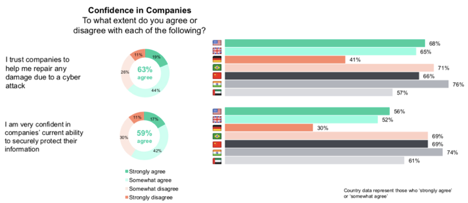How Companies Can Improve User Safety
By Helena Miller
May 28, 2021
During a time in which there is a rising prevalence of user safety attacks, only 20% of Americans totally trust the organizations they interact with to maintain the privacy of their data. More importantly, out of the 80% of Americans that do not totally trust these organizations are a lot more concerned that hackers will access their data than companies using it without their permission. More specifically, companies may do the following to user data: sell it to criminals to get into accounts with payment details, target people with phishing attacks, or provide other companies with sensitive information. From conception, any modern enterprise will need to adapt to the times by creating new methods to deal with digital user safety issues. User safety isn’t something that should be trivialized and people who severely threaten the digital safety of others should be properly disciplined.
Overall, there is a shared bias that people have against those controlling their data. While the rewards may not be as great as those of a massive enterprise, the immediate, potential gains from imposing threats on someone’s digital user safety are enough to make them beneficiaries of the cybersecurity war’s outcomes. What’s more, countless people believe that their digital safety is regularly undermined and that they are constantly disenfranchised because many enterprises do not invest enough in creating and enforcing user safety measures.

According to an article by Small Business Trends, 29% of small businesses in a specific survey have an annual budget of less than or equal to $1,000 for their IT security programs. Additionally, “[t]he global cost of data breaches in 2021 is expected to reach $6 trillion annually” because of the fiscal impact of breaches, more regulation, and the challenging process of taking care of cyberattacks that went on over the course of years.
Barriers to Protecting User Safety
Beyond the budget, what are some other concerns that hinder companies’ inability to protect user safety? Research by IBM found that the companies fear that personal data, intellectual property, physical inventory, and huge financial assets will hinder their incapability to protect user safety. Increasing numbers of cyber attacks aimed at businesses are likely responsible for this fear.
The same survey explains how security breaches happen. In most cases, there are either suspicious actors in a foreign country or an inability to help people through technology. Unluckily, many people complain about the growing influence that insiders have in corporations. According to the Harvard Business Review, in the 2016 Cyber Security Intelligence Index, IBM found that 60% of the attacks were executed by insiders. Of these attacks, three-quarters included malicious intent, and one-quarter included inadvertent actors.

Solutions for User Safety
Restrictive security policies seem like the optimal solution. These are policies that prevent insiders from having access to internet systems so that they can do dangerous, controversial activities that put people at risk. But in reality, they hinder productivity, impede innovation, and frustrate users because bad actors can eradicate evidence that proves that they did these activities. When people have tried to identify who these people are, what they have done, and what the negative consequences of their actions are, these efforts have generally resulted in attempts at “zero-trust policy”. Zero trust is a security concept that stems from the belief that organizations should not trust anything inside or outside their capabilities right away and instead must verify everything, such as all that is trying to connect to its systems before granting access. Regardless, there are still numerous options that can enable ordinary people to protect themselves against the prevalent digital user safety threats. Algorithms make finding answers easier, more effective, and more efficient. But, AI might never replace the creativity, collaboration, and problem-solving capacities of humans and unfortunately for cybersecurity professionals, these skills will be greatly needed when it comes to digital user safety threats.
Additionally, consider in-depth analytics. An example of in-depth analytics usage is when a customer and scholars of the Harvard Business School gathered and analyzed terabytes to discover deviations in behavior at the individual level. The benefit of this technology is that it can facilitate people’s ability to identify indications that systems have been compromised. These systems function in a very similar way to anti-bot solutions on a computer but on a much larger scale.
humanID Solutions
As of now, the best immediate choice a company should make is to implement humanID’s SSO and CAPTCHA solutions. humanID’s SSO and CAPTCHA solutions offer the best advantages in terms of security and convenience. By giving each user a non-reversible, hashed identifier, humanID is the identity provider in the SSO relationship. Our technology uses a user’s phone number to verify their login credentials, thus prohibiting the creation of spam accounts. After the first hash, the salted hash is stored as the username for the particular application’s login. Since every user has different hashes for each application they sign up for, humanID protects their information while letting users log into several platforms. Additionally, user phone numbers are immediately deleted upon verification, providing customers with the highest level of privacy protection.
With humanID’s technology, users are guaranteed a convenient and secure login experience. As a nonprofit, humanID is completely dedicated to protecting user safety. Therefore, what better way to offer your client a more secure experience than to partner with us?


